N.C.’s Labor Market Halfway To Another Lost Year
August 3, 2011- North Carolina’s labor market recorded virtually no net job growth during the first six months of 2011. Between December 2010 and June 2011, the state gained only 13,900 more payroll jobs than it lost (+0.4 percent). Though the private sector netted 27,000 positions, a net drop of 13,100 government jobs offset 48.5 percent of the private sector gain. With such weak growth, little progress was made against unemployment. Both the number of unemployed individuals and the share of the labor force that was unemployed rose during the first half of 2011. If current trends hold, 2011 will prove another lost year for working North Carolinians.
Little Progress on The Jobs Front
During the first half of 2011, business establishments in North Carolina added 13,900 more payroll jobs than they cut. The private sector drove that growth by netting 27,000 positions, while the public sector shed 13,100 more positions than it gained. Net declines in state (-10,300) and local (-2,700) government employment accounted for virtually all of the public sector contraction.
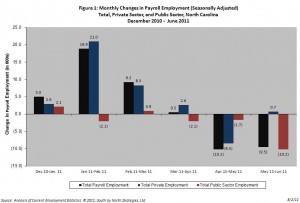 As Figure 1 shows, the pattern of job growth in 2011 varied by calendar quarter. During Q1 (January – March), private payrolls grew, and public payrolls held relatively steady, resulting in a net gain of 33,100 jobs. In Q2 (April – June), private sector growth turned negative, and governmental losses accelerated. The result was a net loss of 19,200 jobs. Put differently, net losses in Q2 erased 58 percent of the Q1 gains. North Carolina therefore had just 0.4 percent more jobs in June 2011 than it did in December 2010.
As Figure 1 shows, the pattern of job growth in 2011 varied by calendar quarter. During Q1 (January – March), private payrolls grew, and public payrolls held relatively steady, resulting in a net gain of 33,100 jobs. In Q2 (April – June), private sector growth turned negative, and governmental losses accelerated. The result was a net loss of 19,200 jobs. Put differently, net losses in Q2 erased 58 percent of the Q1 gains. North Carolina therefore had just 0.4 percent more jobs in June 2011 than it did in December 2010.
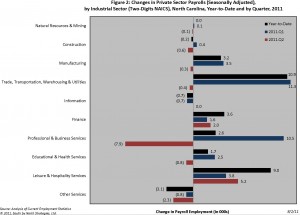 The private sector gains logged during early 2011 did not occur uniformly across industrial sectors (Figure 2). The trade, transportation, and warehousing sector grew the most in absolute and relative terms (+10,900, +0.3 percent), thanks to net growth in retail trade (+8,100). The next fastest growing sector was leisure and hospitality services, which netted 9,000 positions (+0.2 percent), due to growth in accommodation and food services. With the exception of other services, all of the remaining major private sector industries posted few changes in payroll levels. Among those industries, construction employment held steady, while manufacturing payrolls moved up 0.1 percent (+3,200 positions). The increase in manufacturing stemmed mainly from an uptick in durable goods manufacturing.
The private sector gains logged during early 2011 did not occur uniformly across industrial sectors (Figure 2). The trade, transportation, and warehousing sector grew the most in absolute and relative terms (+10,900, +0.3 percent), thanks to net growth in retail trade (+8,100). The next fastest growing sector was leisure and hospitality services, which netted 9,000 positions (+0.2 percent), due to growth in accommodation and food services. With the exception of other services, all of the remaining major private sector industries posted few changes in payroll levels. Among those industries, construction employment held steady, while manufacturing payrolls moved up 0.1 percent (+3,200 positions). The increase in manufacturing stemmed mainly from an uptick in durable goods manufacturing.
The growth trends recorded during the first half of 2011 are inconsistent with the idea that unemployment in North Carolina is due to mismatches between workforce skills and job requirements. The segments of the economy that commonly employ relatively less-skilled workers–segments like retail trade and food services–grew more robustly than many that employ comparatively higher-skilled workers. Within the professional and business services sector, growth occurred chiefly in the administrative and waste management sub-sector (which contains temporary help services), while employment in professional, scientific, and technical services fell.

Job Gap Widens in 2011
The weak job growth recorded during the first half of 2011 did little to replace the jobs lost between 2007 and 2009. Since the onset of the “Great Recession,” North Carolina has lost, on net, 301,000 positions, or 7.2 percent of its payroll base. The maximum job loss occurred in February 2010, when the state had 323,000 fewer jobs (-7.7 percent) than it did 26 months before. While North Carolina subsequently netted 22,000 jobs (+0.6 percent), the growth was too weak to materially alter the employment situation.
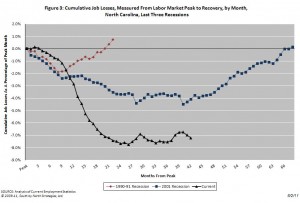 As Figure 3 shows, the job losses recorded during the Great Recession have proven more severe than the ones experienced during the 2001 and 1990-1991 recessions. At the height of the 2001 recession, the state had shed 4.5 percent of its jobs base, while the comparable drop during the 1990-1991 recession was 1.9 percent. In both of those recessions, the job gap began to steadily close after the peak job losses were realized. That has not happened during the current cycle; rather, the job gap began to widen again during the second quarter of 2011.
As Figure 3 shows, the job losses recorded during the Great Recession have proven more severe than the ones experienced during the 2001 and 1990-1991 recessions. At the height of the 2001 recession, the state had shed 4.5 percent of its jobs base, while the comparable drop during the 1990-1991 recession was 1.9 percent. In both of those recessions, the job gap began to steadily close after the peak job losses were realized. That has not happened during the current cycle; rather, the job gap began to widen again during the second quarter of 2011.
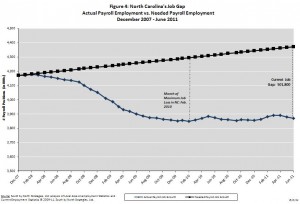 The job shortfall facing North Carolina actually is larger than the one caused by the destruction of jobs during the recession. Since December 2007, the number of working-age Tar Heels has increased by 324,600 (+4.7 percent). This means that the state should have added, on average, 4,800 positions each month just to keep pace with workforce growth. If one considers the jobs that should have been created yet were not, the gap facing the state is 501,800 jobs (Figure 4). To close the gap by June 2015, holding all else equal, North Carolina would need to net 13,939 jobs per month for each of the next 36 months. At no point since 1990 has North Carolina sustained such a level of growth over so long a period.
The job shortfall facing North Carolina actually is larger than the one caused by the destruction of jobs during the recession. Since December 2007, the number of working-age Tar Heels has increased by 324,600 (+4.7 percent). This means that the state should have added, on average, 4,800 positions each month just to keep pace with workforce growth. If one considers the jobs that should have been created yet were not, the gap facing the state is 501,800 jobs (Figure 4). To close the gap by June 2015, holding all else equal, North Carolina would need to net 13,939 jobs per month for each of the next 36 months. At no point since 1990 has North Carolina sustained such a level of growth over so long a period.
Joblessness Remains The Norm
Weak job growth during the first half of 2011 did little to reduce the problems of unemployment and joblessness in North Carolina. The monthly number of unemployed Tar Heels (seasonally adjusted) averaged 438,116 with the average actually increasing somewhat from the first to second quarter. In June, 9.9 percent of the state’s labor force was unemployed, up from 9.8 percent in December 2010. Throughout 2011, the unemployment rate has fluctuated between 9.7 and 9.9 percent.
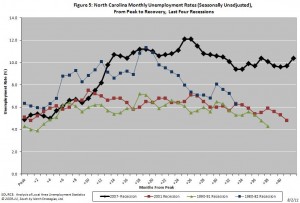 When judged in terms of the statewide unemployment rate (seasonally unadjusted), the recent recession has proven to be the longest and most severe of any post-1980 downturn (Figure 5). Between 1980 and 2008, the highest unemployment rate recorded in North Carolina was 11.3 percent in March 1983. During the same 28-year period, the unemployment rate exceeded 10 percent on just four occasions, all during the early 1980s. Since February 2009, however, the unemployment rate has exceeded 10 percent in 22 of 28 months and has ranged between 9.4 and 12.1 percent.
When judged in terms of the statewide unemployment rate (seasonally unadjusted), the recent recession has proven to be the longest and most severe of any post-1980 downturn (Figure 5). Between 1980 and 2008, the highest unemployment rate recorded in North Carolina was 11.3 percent in March 1983. During the same 28-year period, the unemployment rate exceeded 10 percent on just four occasions, all during the early 1980s. Since February 2009, however, the unemployment rate has exceeded 10 percent in 22 of 28 months and has ranged between 9.4 and 12.1 percent.
In every other post-1980 recession, the state unemployment rate had returned to its pre-recessionary level by 42 months following the onset of the recession. Such a decline has yet to occur during this business cycle. In June 2011, the statewide unemployment rate of 10.4 percent was just 0.2 percentage points lower than the level posted one year before. To return to the same 4.9 percent rate recorded in June 2007, North Carolina’s unemployment rate would need to fall by another 5.5 percentage points.
More Than Unemployment
The size of the state’s civilian labor force (seasonally adjusted) increased during the first half of 2011. Between December 2010 and June 2011, the number of North Carolinians in the state’s labor force rose by 40,360 (+0.9 percent), climbing to 4.50 million from 4.46 million. During that period, the number of employed individuals increased by 31,231 (+0.8 percent), bringing total employment to 4.06 million. The number of unemployed individuals rose by 9,129 individuals (+2.1 percent). Labor force growth resulted from the entrance of individuals entering the workforce for the first time and the re-entry of experienced workers.
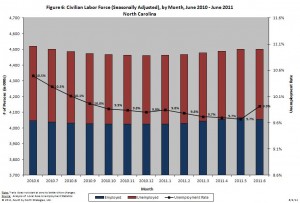 Unfortunately, the slight uptick in the size of the labor force was insufficient to reverse the overall contraction in the size of the labor force that has occurred since 2007. In June 2011, North Carolina’s civilian labor force had 17,970 fewer members (-0.4 percent) than it did in June 2010 (Figure 6) and 58,321 fewer individuals (-1.3 percent) than it did in December 2007. While part of that decline may be attributable to changes in the structure of the workforce (e.g., more people of retirement age), part is likely due to the decision of frustrated job seekers to abandon their searches. This suggests that joblessness is more widespread than reflected in the official unemployment rate.
Unfortunately, the slight uptick in the size of the labor force was insufficient to reverse the overall contraction in the size of the labor force that has occurred since 2007. In June 2011, North Carolina’s civilian labor force had 17,970 fewer members (-0.4 percent) than it did in June 2010 (Figure 6) and 58,321 fewer individuals (-1.3 percent) than it did in December 2007. While part of that decline may be attributable to changes in the structure of the workforce (e.g., more people of retirement age), part is likely due to the decision of frustrated job seekers to abandon their searches. This suggests that joblessness is more widespread than reflected in the official unemployment rate.
Estimates of the underemployment rate, a broader measure of labor under-utilization prepared by the U.S. Bureau of Labor Statistics, indicate that 17.5 percent of North Carolina’s adjusted labor force was underemployed, on average, between the third quarter of 2010 (July – September) and the second quarter of 2011. That measure includes not only individuals who meet the formal definition of unemployment, but also those working part-time despite preferring full-time work and those marginally attached to the workforce. The most recent statewide underemployment rate was down only slightly from the 17.8 percent rate recorded between the third quarter of 2009 and the second quarter of 2010.
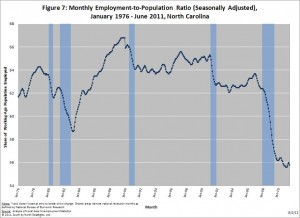 Regardless of the exact measure used, a sizable amount of labor in North Carolina currently is sitting idle. Approximately 10 out of every 100 members of the state’s labor force are unemployed (seasonally adjusted), while nearly 18 out of every 100 are underemployed. Moreover, the share of adult North Carolinians with a job has fallen sharply over the course of the most recent recession. In June 2011, only 55.8 percent of working-age North Carolinians (seasonally adjusted) had jobs, up slightly from the 55.6 percent rate recorded in December 2010. At no other point since 1976 has the employment-to-population been as low as it has been in recent months (Figure 7). The current ratio also is well below the historical average of 63.5 recorded between January 1976 and December 2007.
Regardless of the exact measure used, a sizable amount of labor in North Carolina currently is sitting idle. Approximately 10 out of every 100 members of the state’s labor force are unemployed (seasonally adjusted), while nearly 18 out of every 100 are underemployed. Moreover, the share of adult North Carolinians with a job has fallen sharply over the course of the most recent recession. In June 2011, only 55.8 percent of working-age North Carolinians (seasonally adjusted) had jobs, up slightly from the 55.6 percent rate recorded in December 2010. At no other point since 1976 has the employment-to-population been as low as it has been in recent months (Figure 7). The current ratio also is well below the historical average of 63.5 recorded between January 1976 and December 2007.
Similarly, the June 2011 labor force participation rate of 61.9 percent is the fourth lowest recorded since 1976. Prior to the Great Recession, the participation rate never had fallen below 65.1 percent. While some of that change is likely due to shifts in the age structure of the workforce, the recession has played a driving role. Over time, the degree to which the participation rate rebounds will influence the number of jobs needed to bring down unemployment. The higher the share, the more job growth that will be needed.
Geographic Patterns in Joblessness
During the first half of 2011, labor market conditions remained weak across North Carolina. In June 2011, 68 counties had unemployment rates of at least 10 percent, while 26 counties had unemployment rates at or above 12 percent. Compared to a year earlier, unemployment rates were higher in 43 counties, lower in 52 counties, and unchanged in five counties. (Note: All local figures are seasonally unadjusted, and for the sake of data comparability, this section generally considers year-over-year changes.)
Labor markets in non-metropolitan communities remain particularly weak. In June 2011, the unemployment rate in non-metropolitan North Carolina was 11.3 percent, down from the 11.6 percent rate posted a year earlier. The metropolitan unemployment rate also dropped over the course of the year, falling to 10 percent from 10.2 percent. Meanwhile, 9.8 percent of the labor force residing in the “Big Three” metro areas of Charlotte, the Triangle, and the Triad was unemployed; a year ago the figure was 10.1 percent.
Between the onset of the recession and June, the size of North Carolina’s non-metro labor force declined by 27,253 individuals (-2.0 percent), while the metropolitan labor force gained 50,326 members (+1.6 percent). Within metro North Carolina, growth in the “Big Three” metros accounted for 54.5 percent of the total gain.
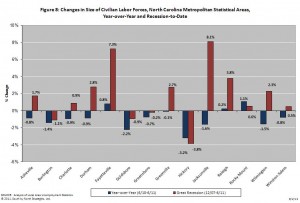 As Figure 8 shows, the labor market performances of North Carolina’s metro areas have varied over the year. Eleven of the state’s 14 areas posted declines in their labor forces with the greatest drops occurring in the Hickory-Morganton-Lenoir (-3.2 percent) and Goldsboro (-2.2 percent) metros. Since the start of the recession, the greatest rates of labor force growth have occurred in the military communities of Jacksonville (+8.1 percent) and Fayetteville (+7.3 percent), followed by Raleigh-Cary (+3.8 percent).
As Figure 8 shows, the labor market performances of North Carolina’s metro areas have varied over the year. Eleven of the state’s 14 areas posted declines in their labor forces with the greatest drops occurring in the Hickory-Morganton-Lenoir (-3.2 percent) and Goldsboro (-2.2 percent) metros. Since the start of the recession, the greatest rates of labor force growth have occurred in the military communities of Jacksonville (+8.1 percent) and Fayetteville (+7.3 percent), followed by Raleigh-Cary (+3.8 percent).
At 8 percent, Durham had the lowest metro unemployment rate in June 2011. The next lowest rate was found in Asheville (8.2 percent), followed by Raleigh-Cary (8.5 percent). The highest rates were in Rocky Mount (13.7 percent), Hickory (12.5 percent), and Charlotte-Gastonia-Rock Hill (11.2 percent).
When looking at local unemployment numbers, it is important to place the numbers in perspective. The 8 percent unemployment rate found in the Durham metro, for example, is low relative to the performance of other North Carolina metros yet is high by any objective standard. Consider how in December 2007 just 3.8 percent of Durham’s labor force was unemployed; 3.5 years later, the area’s unemployment rate was 2.1 times greater, while the number of unemployed residents was 112.8 percent larger. Despite faring better than other metros in the state, Durham’s labor market hardly can be considered healthy.
Economic Hardships Continue to Mount
The lack of jobs continues to be the most serious problem facing working North Carolinians. During the first half of 2011, job openings remained scarce. While state-level information is not available, data from the U.S. Bureau of Labor Statistics suggests that, in the South region, there were 4.8 unemployed workers for every job opening posted in May 2011. In short, there simply were no jobs available for nearly four of every five unemployed Southerners. If the Southern economy had the same number of job openings in May 2011 as existed in May 2007, there would have been 773,000 more job openings and only 2.7 unemployed workers per job opening.
Given the scarcity of job openings, it is not surprising that individuals who have lost jobs are experiencing extended periods of unemployment. In June 2011, the average spell of unemployment spell in the United States was 39.9 weeks. Unfortunately, the longer workers are unemployed, the less likely they are to secure new positions due to competition, skills deterioration, and stereotyping. In fact, recent research has found that some employers are now explicitly refusing to consider unemployed job candidates. If such trends continue, many of North Carolina’s long-term unemployed likely will never return to work.
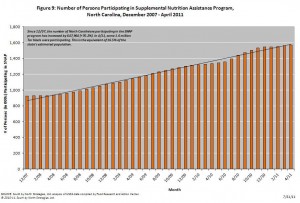 Perhaps the most troubling indicator of the economic hardships facing North Carolina’s households is the surge in the size of the state’s Food Stamp caseload. Between December 2010 and April 2011, the most recent month for which data are available, the number of North Carolinians participating in the program grew by 1.5 percent. Much of the growth is attributable to job losses among individuals with modest incomes — job losses that pushed their household incomes below the eligibility level (gross monthly income of 130 percent of the poverty level or $2,389 for a four-person household). Moreover, since December 2007, the number of Tar Heels participating in the program has grown by 70.2 percent (Figure 9). As of April 2011, some 16.5 percent of the state’s residents were connected to the food assistance program.
Perhaps the most troubling indicator of the economic hardships facing North Carolina’s households is the surge in the size of the state’s Food Stamp caseload. Between December 2010 and April 2011, the most recent month for which data are available, the number of North Carolinians participating in the program grew by 1.5 percent. Much of the growth is attributable to job losses among individuals with modest incomes — job losses that pushed their household incomes below the eligibility level (gross monthly income of 130 percent of the poverty level or $2,389 for a four-person household). Moreover, since December 2007, the number of Tar Heels participating in the program has grown by 70.2 percent (Figure 9). As of April 2011, some 16.5 percent of the state’s residents were connected to the food assistance program.
Second Half Prospects
Halfway through 2011, North Carolina’s labor market appears headed toward another lost year. Since job losses peaked in February 2010, North Carolina has netted just 22,000 payroll jobs (+0.6 percent). That rate of growth is insufficient to keep pace with the natural increase in the size of the state’s working-age population, to say nothing of replacing the jobs lost during the recession.
Unfortunately, it is unlikely that the rate of job growth will accelerate in the second half of 2011. The reductions in state and local government payrolls resulting from the latest round of budget cuts should cause the public sector to drag on employment growth. Similarly, the spending cuts tied to the recent deal pertaining to the federal debt ceiling also should weigh on growth, as should the scheduled expiration of the remaining elements of the Recovery Act, the temporary cut in payroll taxes, and emergency unemployment compensation (Note: If the program lapses, workers losing jobs after July 1 will not receive emergency benefits). Recent data from the private sector also have been troubling and inconsistent with the idea of a rapid bounce back. International instability further clouds the situation.
If recent trends hold, North Carolina’s labor market will not add many jobs in the second half of the year. Even if net job growth remains positive, it likely will be too weak to put much of a dent in the problems of unemployment and underemployment. Economic hardships therefore should remain pronounced. For the long-term unemployed in particular, their odds of returning to work probably will fall, yet the tattered state of the nation’s safety net means that little help will be available for such individuals and their families.
Absent significant changes in public policies, weak job growth, high levels of joblessness, and mounting economic hardships appear to be in store for North Carolina during the second half of 2011.
###
Individuals with a printed copy of this analysis may retrieve it online by visiting http://www.sbnstrategies.com/?p=7712 or by scanning the Quick Response code below.
All material within this analysis Copyright © 2011 South by North Strategies, Ltd.
All rights reserved.



 Email Sign-Up
Email Sign-Up RSS Feed
RSS Feed